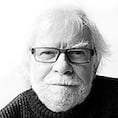Seán McSweeney found his artistic vision and destiny in the Irish landscape – in Wicklow, Sligo and Co Meath. As part of our recent collaboration on the exhibition and book, The Yellow River, it was my great privilege to share his return to that Meath landscape of his childhood, to share not just his personal story and recollections but to witness his process of engagement with what a landscape can transmit to the eye and, in this instance, the memory of the artist.
In his company what struck me most was his keen-eyed, unhurried gaze – the way in which he came under the spell of a vista, resting for a time “in the grace of the world”, as the poet Wendell Berry once put it. The result of Seán’s clear gaze amounted to the rich dividends of his depictions of bog and seashore, land and sky, the field and the pool, the trees of Lissadell and of his own first homeplace in Clongill which he rendered beautifully in a painting with that title that formed part of the Yellow River sequence. It was a gaze that led to the miraculous moment of the vista becoming the work of art.
I think Seán fully understood what the writer Elizabeth Bowen meant when she said that our indigenous landscape had “an air of intense existence”.
His brushstrokes and his technique of paring-back with the palette knife could conjure this intensity in his representations of land, sky and coastline or those stretches of iris and bog cotton he so loved.
While Wicklow was the place where in the early days of marriage to Sheila and fatherhood he developed the gift passed on by his own father, he joins Jack B Yeats as a defining artist of the Sligo landscape, its often dramatic seashore provided an endlessly varied theme for his work as well as the many shifts in perspective that made each individual work so fresh – like a new discovery each time. Its topographical contrasts found a sympathetic artist in Seán who, it would now seem, went west to the Atlantic shoreline when he most needed the test that can make or break a painter. Of course it made him, consolidating his exceptional gifts. Like Yeats, he refreshed the landscape genre, possessed and expressed it – its natural forms and immaterial moods – in his unique way.
He remained loyal to the landscapes of family connection and the familial past – a keeper of his mother’s Sligo, his father’s Co Meath, and Wicklow, where he is now buried in the soil of Hollywood cemetery.
On our journeys back to Meath, to haunts we both cherished and knew from childhood, I travelled with a man of the utmost gentleness and thoughtfulness, one motivated by the proper impulses, an artist of shrewd intelligence and unusual humility, and always a focused dedication. Like any artist of integrity, Seán ignored fashions and trends and kept to his vision and convictions – even, you might say, to his apartness.
When I was first asked by Belinda Quirke, director of the Solstice Arts Centre in Navan, to nominate an artist – in any discipline – with whom I might wish to work, the name that instantly came from my lips was Seán’s.
We had both been aware of and often spoke about our mutual association with the Wilkinstown/Clongill area of Meath – he through his father and me my mother. And so we set out on our artistic adventure, going back to our repository of touchstones to find vestiges of the old life, to retrieve and swap memories, all of which went into the making of his lyrical watercolours and other works and the poems I wrote.
Before the Yellow River paintings, and to my astonishment, Seán had not produced any work out of the terrain in which he spent his early years. Quite unlike his ground in Sligo or Wicklow, Meath presented a new challenge – so these paintings had to be different and they were but without any loss of the McSweeney style and sensibility: a poetic sensibility in how he embodied the landscape in his work, the result of which speaks directly to our emotions, draws us into our own trance of contemplation.
Our collaboration was a high point, and blessing, in my own “creative life”. The bonus was the cementing of a friendship that had preceded our joint venture but also having the opportunity to see at close hand the working methods of a great artist.
Driving through Sligo for his funeral, and then to Wicklow for his burial and remembering those times together in “our most lovely Meath”, I recalled a quote from the poet Derek Walcott that resonates with me when I think of Seán – you can tell a good painter by how much he loves a place.











